18 - 20 June 2010
Friday 18 th June Attendance: 8 With the start-up now just a day away all the intense preparations in the preceding months had lead up to this however there was still much to make ready before we could push the button… The first order of business was to make D8233 ready for its shunt up to Castlecroft yard, it's the forth time that the loco has made this trip during the last 4 years and half years of the restoration, it had been decided that the tarp would be removed completely from the loco. So Jason, Jim, Adam & Rob pitched in to undo the tarp and pull it off the L/H side of the loco onto the floor. From there it was half carried and half dragged up the walkway into the main car park area where it was folded up as tight as we could make it before being carried over to Paddy and stored underneath. Another task that needed to be done before the shunt was to fit the exhaust ports to the roof. These had recently had new wire mesh guards welded on top and spray painted with special high temperature exhaust paint, however it was soon discovered that the exhaust stacks were not central in the roof apertures and it was a tight fit to get the ports to drop in. A hammer had to be used to lightly knock them down in to their rightful place, after which it was time for the shunt. Chris Baily & Chris Tatton had travelled to Castlecroft to fetch the locos that would be used for the move, 20087 & Class 01 D2956, the twenty was used to connect to the line of stock in the siding while other people walked down the sides checking for chocks, hand brakes and obstructions on the rails. D8233 had the power supplies to the loco and the support coaches in front of it disconnected and coiled up out of the way. With the all clear the twenty removed the stock clear so that the 01 could come down and collect D8233. It was noticed that the engine room doors were swinging open this would cause problems during the transit to Castlecroft, so some thin battens of wood were acquired and jammed into the upper handrail to secure the doors. All was ready for the 01 to take D8233 away up the siding and set across onto another road leaving the way clear for the Twenty to put the rest of the stock back. After securing the brakes & chocks back onto the stock the 01 moved forward and the Twenty coupled to the front and so the move up to Castlecroft could begin, as there were trains running that day a signalman was on hand and a path through the station was soon given. 50015 had been parked on the slot leading to the shed but it was started up and moved out of the way allowing the loco convoy to proceed. A small amount of shunting was needed on shed to get everything into position and when everything was placed & secured the final prep work could begin. One major outstanding job was to fit the locking tabs to the generator flywheel, which Chris Baily & Chris Tatton undertook. While this was going on, Steve Foster had arrived and set about connecting the large cables between the buzz bars on the 15's Generator and starter contactors inside the control cubical of 20087 that had been stabled alongside. After this was done Alan Lee & Steve consulted the wiring diagram and were looking for a way to disconnect the exciter and prevent it from energising the main field magnets on the main generator and producing current when its running. All that was needed was small rewire in the Exciters terminal box and the generator was disabled. Over on the other side of the loco a great deal of time and effort was expended in trying to get the hand priming pump working properly to prime the fuel system, one of the flanges was leaking and tightened up, but that caused the flange casting to crack. With the new pump now damaged a plan was hatched to get the old pump and renovate it, So a trip in the car down to Baron St was needed to fetch it and a number of other bits & bobs. Meanwhile the crankcase doors on the R/H side of the engine were being removed so to allow the crankshaft bearings to be observed when the oil priming pump was run to check for oil flow. This test was successful but it highlighted a number of other leaks mostly on ermeto pipe connections both in the cooler group and the hoses off the front of the engine. These were duly tightened with a large wrench. The old fuel-priming pump had been worked on and refitted to the loco; it was tested and seemed to be working properly. So the fuel system was fully primed. The final task was to rig up a battery supply to engine run solenoid located within the governor, two car batteries, were used along with some wiring and a switch and all was ready to go. The decision was taken to do a cranking test, this would check that the generator could properly spin the engine, it would operate the main ,mechanical oil pumps on the engine and give greater oil pressure. So with everyone clear and in observation positions the engine was cranked over for around 60 seconds, the generator whirred was it spun over for the first time since overhaul as Alan was held the fuel rack shut When the minute was up the engine was stopped and all the bearings were checked for overheating and all was well, the higher oil pressure did reveal a couple more minor leaks that were dealt with but overall it had been a successful test, with everyone happy the loco was secured and the jump leads disconnected, for tomorrow would be an auspicious day. Saturday 19 th June (The First Start-up of D8233 in Preservation) Attendance: Many The Big day dawned and final prep work to get the loco set up for the start-up duly proceeded. This mainly entailed the reconnection of the thick Traction cables from the cubical of 20087 to the buzz bar terminal on the back of the genny. At the front of the engine the car batteries with the inline switch that supplies current to the engine run solenoid within the governor housing was set back up and tested, the lead from the battery charger inside the shed was run out and plugged into the oil priming pump as this would supply power to it. In the run up to the 11:00 deadline a number of people began to congregate around the access gate to the Castlecroft shed area, the final steps to start-up were positioning people in strategic spots to watch parts of the engine & cooler group when the engine was started and running to make sure that no obvious mechanical faults or leaks were evident. Alan Lee took up position next to the engine instrument panel and would directly control the fuel rack by hand during the start, Jim & Rob were positioned either side of the generator and each had a flat board in their hands which would be used to block up the Turbo air intakes and starve the engine of oxygen should it start to run away. Adam was watching the L/H side of the engine through the open doors and Chris Baily was viewing the R/H side, Matt Hainsworth was the observer inside the cooler group while Chris Tatton manned the Battery charger that powers the Oil priming pump. Carl Holt would be seated inside the cab of 20087 to push the start button when required, once everyone was in position Alan gave the signal to run the Oil priming pump and begin the start-up procedure. The oil pump was run for around 20 sec and made it usual grumbling sound, once suitable pressure was attained Alan told Chris to stop the pump and then asked if the battery switch was in on the Class 20, Dave Mylett confirmed that it was, Chris Baily manned the switch for the engine run solenoid and Alan then checked that everyone on the loco was clear of the engine and ready for the start. He then requested a one second dab on the start button, Carl did this and the Start contactors on the twenty clattered as engine turned through couple of rotations, this was to check that the engine was rotating in the right direction after the starter cables had be removed & refitted overnight. With everything ready Alan asked Carl to begin Cranking the engine, again the Twenty start contactors made contact and the engine began to turn, it slowly picked up speed and the whining noise from the freshly cut commutator as the new carbon brushes ran across them was quite loud, as the engine spun up to speed mechanical clattering sounds from its internal workings emanated from the engine. It was cranking for some 16 seconds before the first puffs of smoke erupted from the exhaust stacks, the engine chuffed, then chuffed again as white smoke issued from the stacks, the cylinders now began picking up as more and more began to fire, eventually the engine erupted into life, the turbos began to spool up with a hint of the characteristic napier whistle and the fan in the cooler group also span into life quite vigorously and the with the radiator shutters shut it dragged the air through the nose end compartment and sucked the R/H door to with a slam. The engine now began idle and plumes of white smoke issued from the exhausts. In typical Paxman fashion it was a very smoky start-up the wind curled the smoke around in front of the shed building and for a few moments everything was enveloped in the white clag. The engine was running a little lumpy at first as the individual cylinders, which had been dormant for many years were suddenly forced into motion, there were a few unusual noises that developed during the first run, some light tapping & pinking noises, but as the engine ran these sound gradually settled down as pressurised oil finally reached the more remote recesses of the block, with the engine mechanical pumps now working the oil pressure was over 70 psi which was excellent. Alan went through a process of testing each of the fuel pumps to see which were missing by over fuelling each one individually and seeing if the engine note changed with slight burps from the exhaust, The smoke was very thick to begin with and through the action of the wind it travelled down through the tunnel to the station where it dissipated, the whole engine was checked over while it was running and a few minor leaks were discovered. The sound of the engine was quite interesting, when ticking over it could be said that it sounded a bit like a Hymek idling, but the exhaust beats were not as harsh and it had the slight napier twitter with it, other people suggested that it sounded like an Alco or an un-silenced GM engine, after some eleven & half minutes Chris B hit the electric switch that de-energised the run solenoid and the engine ran down and stopped, It had been noticed that some of the split pins in the crankshaft bolts were slightly loose and striking the timing marker, this was duly rectified and the crankcase doors were removed from the R/H side so that the main crankshaft & big end bearings could be checked for any over heating or distress. Fortunately all were nice & cool so the doors were refitted, after further checks the crew had a cupper before doing the second start-up at around 11:38. This time the engine fired up a lot more readily and soon settled into a regular beat it was still smoking quite a bit but as the 2 nd run went on the smoke gradually began to ease as the engine slowly came up to operating temperature. During the second run an opportunity was taken to snap a seminar picture with all the Class 15 workers in attendance, having not had one since the loco first arrived back on the ELR in Feb 2006 now seemed like a good time to have one, so they climbed up the ladder and stood along the R/H sole and included from Left to Right, Rob Mason, Kris Mason, Jason Lovell, Jim Gough, Adam Booth, Carl Holt, Chris Baily, David Mylett & Chris Tatton, after the pics were taken and the obligatory Flailing shot, the rest got down while Carl moved over to get his hand on the throttle lever and gave the engine a few revs. As the revs increase the engine chugs a little as it speeds up and the turbo starts to whine a little, the pulses of the cylinders begin to race and the overall sound is quite interesting, however as the engine was under no load it was only run up to around 3 rd throttle so there is a lot more noise to come from this machine yet. The smoke was clearing away nicely on the R/H bank but was still issuing from the L/H side, Les Tappenden was investigating the reason and noticed that dirty fuel was seeping out of the manifold for cylinder B2 by the cooling knuckle, upon feeling the exposed section of the manifold he found it to be cool. Through further investigations it was discovered that the injector pump was not working properly, as such the fuel in that cylinder was not being burnt correctly and that was the reason for the excessive smoke from the L/H bank. However we have plenty of spare fuel pumps and it will be a simple matter to swap one over to fix this problem. After 32 mins of running the engine was shut down and final checks were done to the engine to check that all was well, aside from a couple of minor oil leaks and the dicky fuel pump it the first runs of Paxman 16YHXL engine No. 55902 in D8233 had been a very successful. After disconnecting the life support cables the body side doors were secured and all the tools we had bought down were placed in the nose end compartment. D8233 was again shunted back down to Baron St with D2956 in the lead this time. On being shunted back into its place on the siding at Baron St it was all hands on deck to pull the tarp back over the loco and tie it down, after which a project meeting was held by all present in the meeting room of the steam department to thrash out the restoration plans for all the locos over the 2 nd half of the year. Today had been a milestone in the restoration of D8233 and a landmark event in history of Diesel Preservation in the UK and its something that everyone who helped to make it happen should be justly proud. Sunday 20 th June Attendance: 4 As the significance of the previous days event had yet to fully sink in today would be a lot more relaxed, as it was supposedly a Co-bo weekend Adam was determined to do something on the Object Jason, Chris & Rob tackled the task of relocating all the electrical equipment from the secure store down workshop space that had been cleared in Paddy passenger compartment. So using Robs van and Jason's car the group managed to get all the electrical control cubical parts out of the store and down to Baron St. Where by they were hand-balled into the coach and carefully stowed until the time comes for work to begin on sorting all this control gear out and creating D8233's replacement electrical cubical. This took most of the morning and as both Chris & Rob had to depart early that left Jason & Adam to continue onwards. The rest of the afternoon was taken up by Painting and as Adam had undercoated the top genny bulkhead plate off the Co-bo it was decided to make a start on painting the Co-bo roof sections. Adam had undercoated the topsides of the two large roof sections earlier in the day and come the afternoon the paint had dried and he could apply the gloss roof paint that had recently been purchased. Jason applied a second coat of interior gloss to the two smaller roof panels (as the undercoat stage had been missed?) and after this had all been down it was time for Adam & Jason to leave a little earlier than normal for a Sunday afternoon. With the work for the rest of the year planned out at the Project meeting the previous day. The main focus of the work for now is to get the floor area of the Cab and short nose end drelled & painted, then get the repairs on the cab completed & painted so that it can be re-fitted later this year. So after all the trials and tribulations of the last four & half years culminating in the glorious sound of a running Paxman engine, we've come so far, but we still have a long way to go. If you wish to lend a hand please contact Chris Tatton |
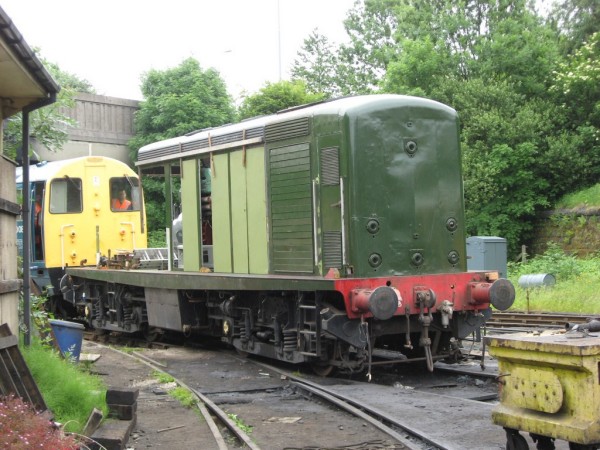 |
| Above : D8233 is carefully shunted into position at Castlecroft by 20087. © C15PS |
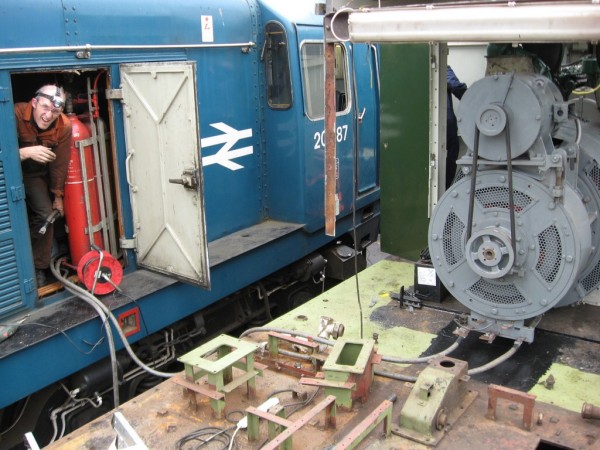 |
| Above : Steve Foster emerges from 20087's cubical while connecting the Jump leads. © C15PS |
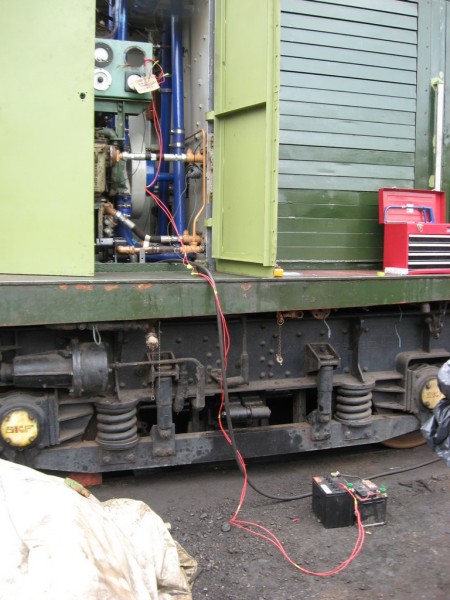 |
| Above : The engine run solenoid in the govenor was also wired up like so. © C15PS |
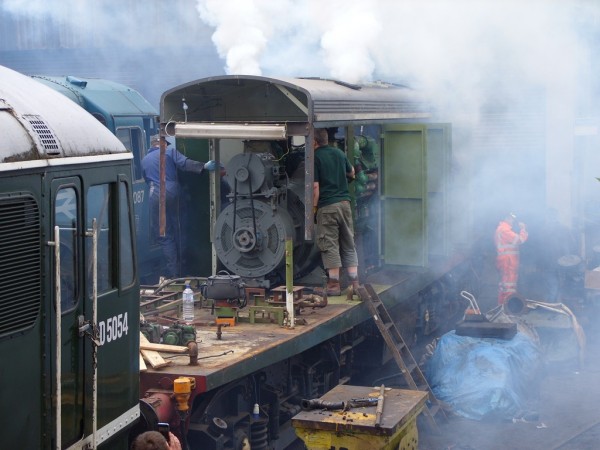 |
Above : The first start-up was quite smokey as you can see here. © C15PS |
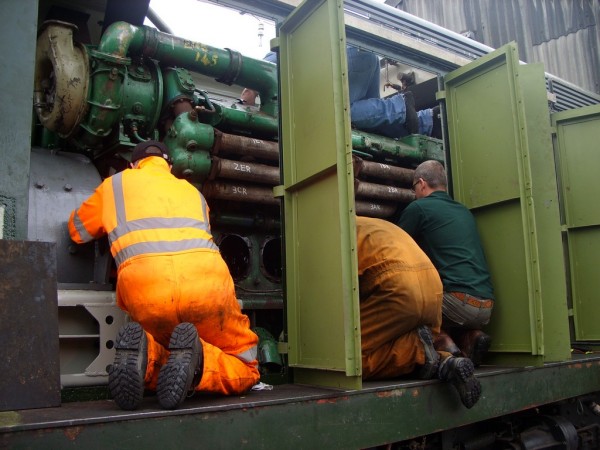 |
Above :
After the first run the crankcase covers were removed and bearings checked. © C15PS |
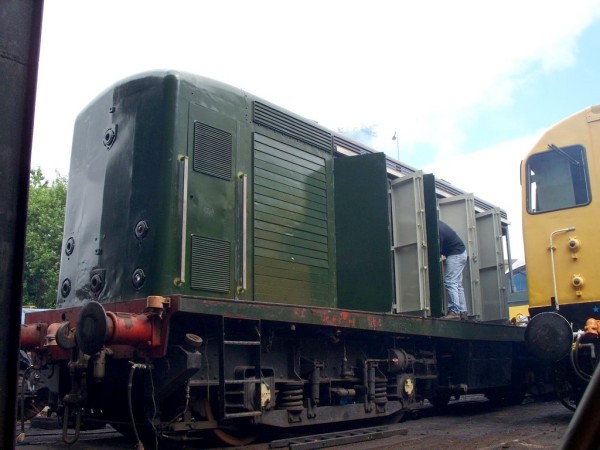 |
| Above : During the 2nd run a problem was found with one of the L/H side Fuel pumps. © C15PS |
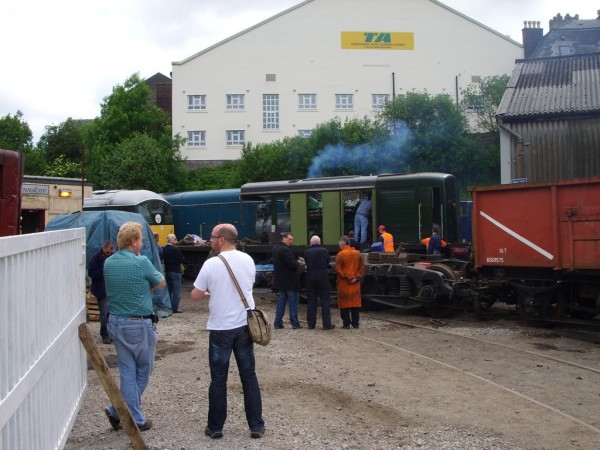 |
| Above : Quite a crowd had gathered and the smoke mostly cleared by the end. C15PS |
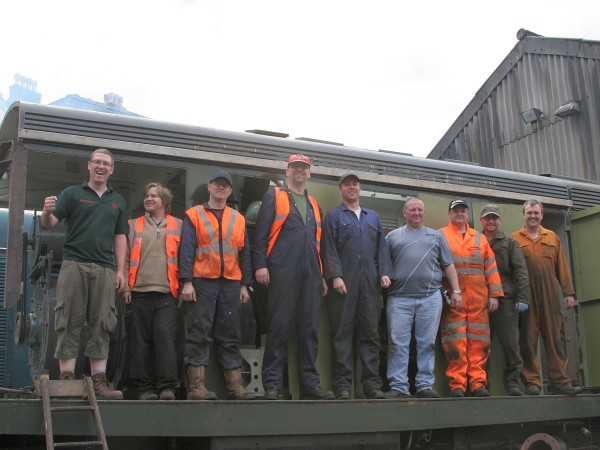 |
| Above : Left to right: Rob Mason, Kris Mason, Jason Lovell, Jim Gough, Adam Booth, Carl Holt, Chris Baily, David Mylett, Chris Tatton. © C15PS |
 |
| Above : A view of the engine starting. © C15PS |
 |
| Above : Plenty of smoke.. © C15PS |
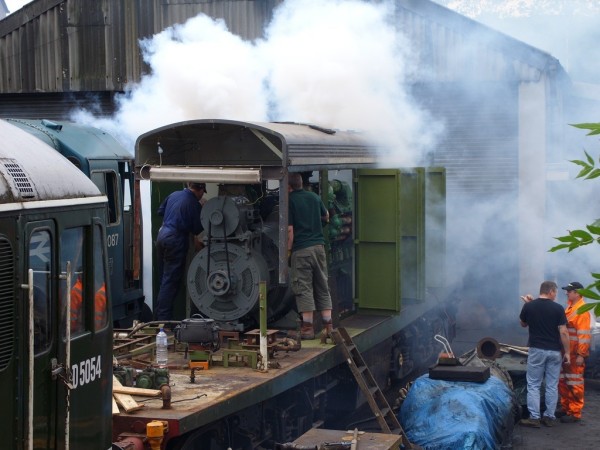 |
Above : Another view of the engine running. © C15PS |
Fancy Getting Involved? click on the You Can Help page